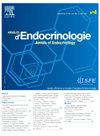遗传性原发性甲状旁腺功能亢进症的临床表型和遗传筛查:单中心病例系列。
IF 2.9
3区 医学
Q3 ENDOCRINOLOGY & METABOLISM
引用次数: 0
摘要
遗传性原发性甲状旁腺功能亢进(PHPT)是一种单基因常染色体疾病,占所有PHPT病例的5-10%。关于中国人群遗传性PHPT的资料很少。目的了解天津医科大学总医院遗传性PHPT的病因、表型、基因型、治疗和预后,扩大致病基因谱,评估临床表型的年龄依赖性外显率。此外,基因型与表型的相关性在多发性内分泌肿瘤1型(MEN1)中进行了探讨。方法回顾性分析2008年1月1日至2024年7月31日患者的临床表现、生化指标、影像学表现及全外显子组测序结果。结果本研究共纳入73例。MEN1占主导地位(80.8%),其次是甲状旁腺功能亢进-下颌肿瘤综合征(9.6%)、家族性低钙高钙血症(5.5%)、MEN2A(2.7%)和家族性孤立性甲状旁腺功能亢进(1.4%)。男女性别比为1:6 .6。30例(41.1%)表现为多腺甲状旁腺受累。57例患者的基因检测发现了12种新的突变,其中70.2%含有致病性或可能致病性变异。PHPT突变携带者首次出现的平均年龄为42.0±14.5岁,45岁时的外显率为64.3%。MEN1突变未观察到显著的基因型-表型相关性。结论本病例系列揭示了遗传性PHPT的临床表型和突变谱,强调了基因检测在亚型分类、并发症监测、治疗指导和家庭监测中的作用。对于早发、复杂临床表现、多腺体甲状旁腺受累或家族史的PHPT患者,建议进行基因检测。本文章由计算机程序翻译,如有差异,请以英文原文为准。
Clinical phenotypes and genetic screening in hereditary primary hyperparathyroidism: A single-center case series
Background
Hereditary primary hyperparathyroidism (PHPT) is a monogenic autosomal disorder, constituting 5–10% of all PHPT cases. Data on hereditary PHPT in the Chinese population are scarce.
Purpose
This study aimed to delineate the etiology, phenotype, genotype, management, and prognosis of hereditary PHPT in Tianjin Medical University General Hospital, expanding the spectrum of pathogenic genes and evaluating the age-dependent penetrance of clinical phenotypes. Additionally, genotype-phenotype correlations were explored in multiple endocrine neoplasia type 1 (MEN1).
Methods
A retrospective analysis of medical records from January 1st, 2008 to July 31st, 2024 included clinical presentations, biochemical markers, imaging findings, and whole exome sequencing.
Results
The study comprised 73 cases. MEN1 was predominant (80.8%), followed by hyperparathyroidism-jaw-tumor syndrome (9.6%), familial hypocalciuric hypercalcemia (5.5%), MEN2A (2.7%), and familial isolated hyperparathyroidism (1.4%). The male:female sex ratio was 1:1.6. Thirty patients (41.1%) exhibited multiglandular parathyroid involvement. Genetic testing in 57 patients identified 12 novel mutations, with 70.2% harboring pathogenic or likely pathogenic variants. Mean age at initial presentation for PHPT mutation carriers was 42.0 ± 14.5 years, with 64.3% penetrance by 45 years of age. No significant genotype-phenotype correlations were observed for MEN1 mutations.
Conclusion
This case series provided insight into the clinical phenotypes and mutational spectrum of hereditary PHPT, emphasizing the role of genetic testing for subtype classification, complications monitoring, treatment guidance and family surveillance. Genetic testing is recommended for PHPT patients with early-onset, complex clinical presentations, multiglandular parathyroid involvement or family history.
求助全文
通过发布文献求助,成功后即可免费获取论文全文。
去求助
来源期刊

Annales d'endocrinologie
医学-内分泌学与代谢
CiteScore
4.40
自引率
6.50%
发文量
311
审稿时长
50 days
期刊介绍:
The Annales d''Endocrinologie, mouthpiece of the French Society of Endocrinology (SFE), publishes reviews, articles and case reports coming from clinical, therapeutic and fundamental research in endocrinology and metabolic diseases. Every year, it carries a position paper by a work-group of French-language endocrinologists, on an endocrine pathology chosen by the Society''s Scientific Committee. The journal is also the organ of the Society''s annual Congress, publishing a summary of the symposia, presentations and posters. "Les Must de l''Endocrinologie" is a special booklet brought out for the Congress, with summary articles that are always very well received. And finally, we publish the high-level instructional courses delivered during the Henri-Pierre Klotz International Endocrinology Days. The Annales is a window on the world, keeping alert clinicians up to date on what is going on in diagnosis and treatment in all the areas of our specialty.
 求助内容:
求助内容: 应助结果提醒方式:
应助结果提醒方式:


